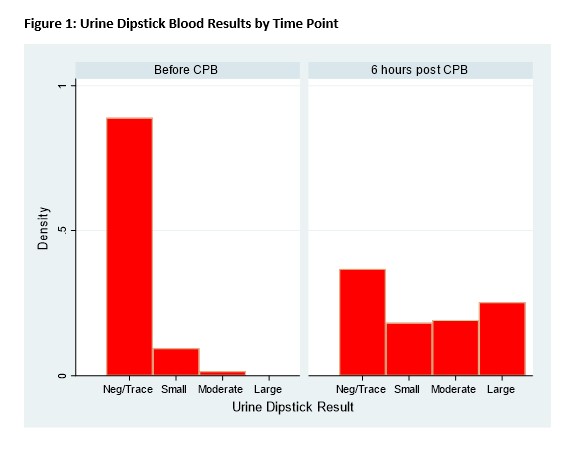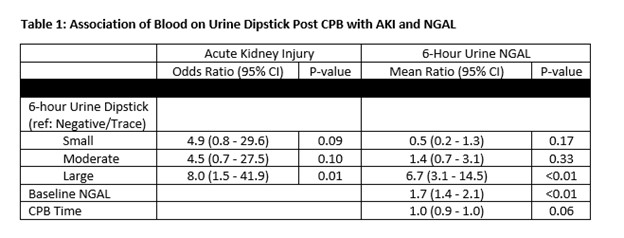Nephrology
Session: Nephrology 3
14 - Urine Dipstick Blood and Acute Kidney Injury in Neonates Undergoing Cardiopulmonary Bypass
Sunday, May 5, 2024
3:30 PM - 6:00 PM ET
Poster Number: 14
Publication Number: 14.1738
Publication Number: 14.1738

Amy Strong, MD MSCE (she/her/hers)
Instructor of Pediatrics - Nephrology
University of Iowa Stead Family Children's Hospital
Iowa City, Iowa, United States
Presenting Author(s)
Background: Cardiopulmonary bypass (CPB) is associated with acute kidney injury (AKI). While this is likely multi-factorial, there is evidence that free hemoglobin generated from mechanical hemolysis is toxic to the kidney tubules.
Objective: The aim of this study was to determine if urine dipstick blood levels in infants post CPB associated with AKI and urine neutrophil gelatinase-associated lipocalin (NGAL) levels.
Design/Methods: Infants < 1 year of age who underwent CPB at a single center were enrolled prospectively between October 2017 and June 2019. Urine samples from two time points: baseline (prior to CPB) and 6 hours post CPB were previously collected and stored at -80°C, and then analyzed in batch for NGAL and dipstick blood. Urine dipstick values were categorized: 0 (trace/negative), 1 (small), 2 (moderate) and 3 (large). AKI was defined by creatinine-based KDIGO criteria within 72 hours of CPB. Additional covariates were extracted from the electronic medical record.
Spearman correlation was used to examine the association between urine dipstick blood and NGAL at each time point. Linear regression was used to estimate the association between urine dipstick blood and log-transformed NGAL at 6 hours post CPB, controlling for baseline NGAL and bypass time. Logistic regression was used to estimate the association of AKI and with urine dipstick blood and NGAL.
Results: 134 infants were included of whom 50 had both baseline and 6-hour samples, 48 had only 6-hour samples and 13 had only baseline samples available. At baseline, 7/63 (11%) had >trace blood. Six hours post CPB, 62/98 (63%) had >trace blood, 26% of whom had 3+ blood (Figure 1). 18/98 (18%) had AKI.
Urine dipstick blood values correlated with urine NGAL 6 hours post CPB (r=0.52, p< 0.01), but not at baseline (r=.06, p=0.66). Those with large blood on urine dipstick had 6 times higher mean NGAL values compared to negative/trace (mean ratio: 6.6, 95% CI: 3.1-14.4, p< 0.01). Those with large blood had 8 times higher odds of AKI (OR: 7.99, 95% CI: 1.5-41.9, p=0.01) (Table 1). Urine dipstick blood 6 hours post CPB predicted AKI better than urine NGAL at the same time point (AUC: 0.7 vs. 0.6).
Conclusion(s): Urine dipstick blood post CPB may be a good predictor of AKI in neonates. The correlation between AKI and blood on urine dipstick following CPB indicates that intravascular hemolysis may be an important contributor to the development of AKI in this population.


